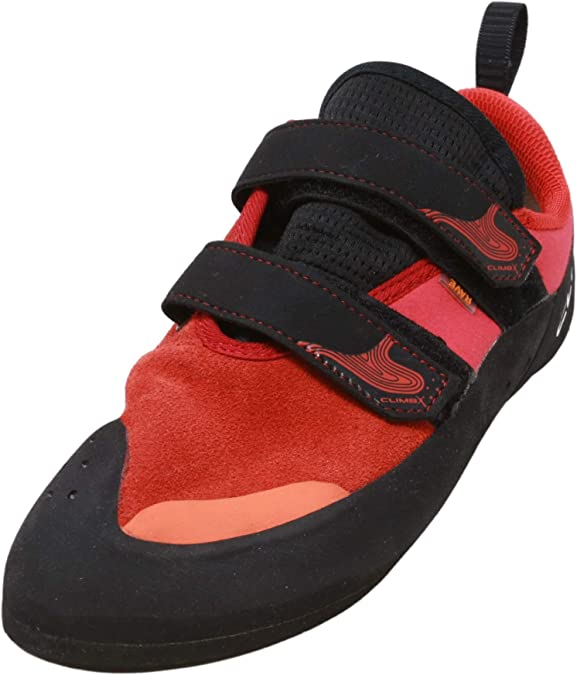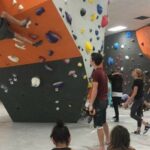How Should Rock Climbing Shoes Fit – Climbing On Trad And Cracks
I’m sure you’ve heard the age-old myth that if you want to crush hard, you need to wear absurdly small climbing shoes. I’m sure you’ve seen guys at the bouldering gym pushing their feet into ridiculously small shoes. Before you go out and buy shoes four sizes too small, let me assure you that you don’t have to be in toe-crushing pain to have a perfect-fitting pair of climbing shoes.
So, how tight should climbing shoes be, you ask? That’s an excellent question! In reality, a variety of factors influence how tight rock climbing shoes should be. The best fit for your climbing shoes will depend a lot on the structure of the shoes, the terrain, and how hard you climb.
Here, I’d want to highlight some of the most essential aspects that influence how tight climbing shoes should be, so you can make an informed decision when purchasing a new pair of climbing shoes. How should climbing shoes be worn? First and foremost, let’s talk about how climbing shoes should fit.
Your climbing shoes should be as snug as a second skin, with no dead space or hotspots. If your shoes feel like they’re exerting too much pressure on your toe knuckles or crushing the sides of your feet, it will have a big influence on how much force you can transfer to your toes and how long you can wear them.
Similarly, if your shoes are excessively large and there is dead space at the tip of the shoe, your ability to stand on little edges would be severely hampered. Or, if there’s too much room beneath your heel, you won’t achieve the suction fit you need to put those horrible heel hooks.
Don’t forget to check out more interesting climbing content, only on Cruxcrush.com
How downturned and soft your shoes are two of the most important criteria that will govern how to fit your climbing shoes, which we shall examine in further detail momentarily. However, whether you’re wearing a flat-lasted shoe or an aggressively downturned monster, your toes in climbing shoes should always be curled.
Again, with climbing shoes, your toes should never be entirely flat. This is because curling your toes even slightly helps you carry substantially more weight on narrow edges. The degree to which your toes curl, and hence how tight your climbing shoes feel, depends on the factors I’m going to provide. Factors influencing how tight climbing shoes should be
CLIMBX Rave Strap Men’s Performance Rock Climbing Shoe

A great all around comfortable shoe that is precise enough for your next gym session. Features double stitch construction, padded collar and heel, polypropylene midsole and one-piece binding. Size up for a comfort fit and size down for a more aggressive performance fit but keep in mind that climbing shoes are supposed to fit very tight and at a minimum your toes should be touching the end of the shoe.
Construction Of Shoes
The structure of each individual shoe should have the most effect on how tight your climbing shoes should be. The three key factors to consider here are the shoe’s stiffness, camber, and top material. Let’s take a short look at each of those elements separately.
Soft Or Firm?
One of the most important things that affect how fit climbing shoes is how stiff they are, which is strongly linked to how they are shaped. Stiffer climbing complements neutral and moderate forms. As previously said, your toes will not be firmly curled in these climbing shoes, as they would be with aggressive shoes.
As a result, shoemakers utilize a firmer midsole and/or outsole to offer more support to your toes. This rigid base allows you to burden your toes without them being in that forceful curled posture, allowing you to wear these shoes more casually.
Soft shoes, on the other hand, are a very different beast. The final form of soft shoes is nearly always moderately or forcefully downturned. This is because they rely on a tight fit to provide stiffness.
Let me say that again. These shoes rely on your foot’s opposing force against the shoe’s tensioned rand mechanisms to keep them stiff. This innovative design works like an elastic band when it’s stretched: it creates resistance, which keeps the shoe tight around your foot and gives you stability when you’re standing on narrow footholds.
It is very necessary to wear tight-fitting shoes to produce this tension. Allow me to give you an example. Two photos of me wearing the Scarpa Instinct VSR are included below. The right foot is beautiful, but the left foot is not. Is there a difference?
If you look closely at the photographs above, you’ll notice that the left shoe generates substantially less stress, indicating that the forefoot was unable to become stiff. As you can see, my whole forefoot is flat on the floor. As a result, my ability to edge with this foot will be severely hampered. The right foot, on the other hand, fits significantly better, and the forefoot does not rest flat due to the tighter fit, providing far superior support on tiny holds.
Camber
The camber, often known as a shoe’s downturn, will have a significant impact on how tight climbing shoes should be. Shoes with a downturned form, as you can see above, are designed to curl your toes and hold your foot in a forceful foot posture, allowing you to hold your weight on the slightest of holds. If your foot is too flexible within an aggressive climbing shoe, it won’t be able to keep your toes curled.
Don’t interpret this as a recommendation to force your foot into the tiniest shoe possible. There are also complications linked with wearing aggressive shoes that are overly tight. Aside from the painful discomfort and negative effects on your overall foot health, too curled toes within the shoe will limit the sensitivity and ability to stand on your toes.
The Content
When it comes to sizing climbing shoes, the material of the top is less important, but it’s still worth mentioning. Uppers are often categorized as leather, synthetic, or a hybrid of the two.
The key point to remember here is that leather stretches substantially more than synthetic shoes, particularly unlined shoes. In reality, unlined leather can stretch up to whole shoe size. If you want to buy a pair of leather climbing shoes, buy them a little tighter to account for the stretching that will happen when you first wear them.
Climbing Style
Even though this depends on how the shoes are made and how they are meant to be used, let’s quickly talk about the most common climbing styles and how they affect how to fit climbing shoes.
Sport Climbing And Bouldering
If bouldering is your major discipline or you prefer pushing yourself on steep sports routes, you will most likely be looking for a moderate or aggressive shoe. As previously said, these shoes require a tighter fit in order for the tension rands to work their magic.
Because you’re only on the wall for a few minutes during bouldering or sports climbing, many climbers value performance over comfort. While your shoes should never cause you agony, a little discomfort is OK because you’ll be taking them off after every couple of burns.
All-day And Multi-Pitch Usage
Even though a tight-fitting shoe with a downturned toe may work best on steep terrain, you don’t need to wear them when cruising down gentle slopes that are well below your technical limit. A climber seeking an all-day shoe would most likely choose a moderate or flat shoe. Therefore, a tight fit with slightly curled toes is the best shoe for these scenarios.
For all-day wear, I recommend a more comfy and supportive shoe to keep your toes from crying out in pain. You still want your toes to be softly curled; however, they shouldn’t be curled up as tightly. When first trying them on, they should feel snug but not cause any discomfort. If you want to transport the shoes to the Alps, you might consider sizing them large enough to include socks.
Climbing On Trad And Cracks
Consider the particular pressure points that jamming can cause if you’re a crack climber. When jamming, aggressively fitted, downturned shoes will not only cause great discomfort but will also be ineffective at jamming into the crack. A traditional shoe, like an all-around shoe, should give a flatter, supporting platform to stand on, as well as some room to move about while torquing the foot. This indicates that the toes should be contacting the end of the shoe but not too curved.
Intensity
The final point I’d want to mention briefly is intensity. Regardless of whatever climbing methods you intend to pursue, the intensity with which you perform them will influence how tight your shoes should be.
When I’m just running training laps in the bouldering gym or having a more casual climbing day, I wear shoes with a looser fit and less aggressive downturn because comfort is more important to me than performance.
If I’m working on a bouldering project, I’ll put on my tighter shoes, which provide a performance fit and help me get every last drop of performance from them. Similarly, if you want to tackle a difficult traditional route that will put your technical abilities to the test, performance will take precedence over comfort, and a tighter shoe will be necessary.
CLIMBX Rave Strap Men’s Performance Rock Climbing Shoe

A great all around comfortable shoe that is precise enough for your next gym session. Features double stitch construction, padded collar and heel, polypropylene midsole and one-piece binding. Size up for a comfort fit and size down for a more aggressive performance fit but keep in mind that climbing shoes are supposed to fit very tight and at a minimum your toes should be touching the end of the shoe.
Conclusion
So, how snug should your climbing shoes be? As you can see, fitting climbing shoes ultimately comes down to personal choice and the design of each unique shoe. So it’s okay if you don’t get the size just right the first time. They’ll probably perform alright as long as they feel right for you at the moment. If you’re a novice, once you’ve outgrown your present shoes, you’ll have a pair to use as comfortable trainers or all-day multi-pitchers.
The best choice is to try them on in person if at all feasible. Don’t be scared to request a single shoe in three different sizes and try them on against the store wall. If there are no physical stores in your region, look for an online retailer with a decent return policy (like Amazon) where you may purchase multiple sizes and return the ones that don’t fit.






